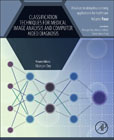
Classification Techniques for Medical Image Analysis and Computer Aided Diagnosis
Dey, Nilanjan
Classification in Clinical Applications covers the most current advances in applying classification techniques to a wide variety of clinical applications, appropriate for researchers and biomedical engineers in the areas of machine learning, deep learning, data analysis, data management, and computer aided diagnosis (CAD) systems design. Classification techniques are used for medical image analysis as a part of computer aided diagnosis systems, which employ machine learning, data analysis, pattern recognition and other deep learning techniques. Classification is an important statistical/mathematical tool used to refine and analyze complex systems such as medical images. The clinical applications can be across a wide range of diseases/procedures/specialties and are included as examples in the book. The book covers several complex image classification problems using pattern recognition methods, including Artificial Neural Networks (ANN), Support Vector Machines (SVM), Bayesian Networks (BN), and deep learning. Further, numerous data mining techniques are discussed, as they have proven to be good classifiers for medical images because they contain tools for data pre-processing, classification, regression, clustering, association rules and visualization. Medical image classification is essential for accurate diagnosis and development of computer aided diagnosis (CAD) systems in clinical applications. For physicians, automated classification of medical images is an increasingly significant tool in their daily activity. Advances in medical imaging technology supported by computer science have enhanced interpretation of medical images and contributed to early diagnosis. The development of CAD systems provides a method of assisting physicians in the detection of abnormalities, quantification of disease progress and alternate diagnosis of lesions. Extraction of appropriate features is a vital step in any image classification. Furthermore, since medical images are often highly textured, texture analysis becomes crucial in medical image analysis. Examines the methodology of classification of medical images that covers the taxonomy of both supervised and unsupervised models, algorithms, applications and challengesDiscusses recent advances of Artificial Neural Networks, machine learning, and deep learning in clinical applicationsIntroduces the several techniques for medical image processing and analysis for CAD systems design INDICE: 1. Classification of Unhealthy and Healthy Neonates in Neonatal Intensive Care Units Using Medical Thermography Processing and Artificial Neural Network 2. Use of health related indices and classification methods in medical data 3. Image Analysis for Diagnosis and Early Detection of Hepatoprotective activity 4. Characterization of Stuttering Dysuencies using Distinctive Prosodic and Source Features 5. A Deep Learning Approach for Patch Based Disease Diagnosis from Microscopic Images 6. A Breast Tissue Characterization Framework Using PCA and Weighted Score Fusion of Neural Network Classifiers 7. Automated Arrhythmia Classification for Monitoring Cardiac Patients Using Machine Learning Techniques 8. IoT Based Fluid and Heartbeat Monitoring For Advanced Healthcare
- ISBN: 978-0-12-818004-4
- Editorial: Academic Press
- Encuadernacion: Rústica
- Páginas: 232
- Fecha Publicación: 01/11/2019
- Nº Volúmenes: 1
- Idioma: Inglés
